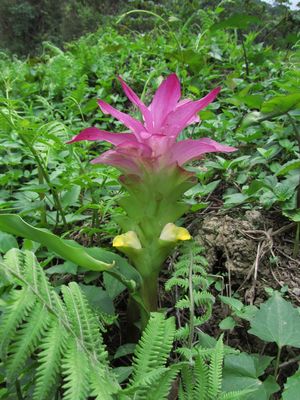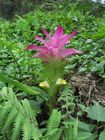Note: This is a project under development. The articles on this wiki are just being initiated and broadly incomplete. You can Help creating new pages.
Curcuma aromatica - Wild turmeric, Aranyaharidra
Curcuma aromatica is a member of the Curcuma genus belonging to the family Zingiberaceae. Botanically close to Curcuma australasica, wild turmeric has been widely used as a cosmetic herbal in South Asia and nearby regions.
Contents
[hide]Uses
arthritis, heartburn, joint pain, stomach pain, ulcerative colitis, bypass surgery, diarrhea, intestinal gas, loss of appetite, jaundice, liver problems, Helicobacter pylori, stomach ulcers, irritable bowel syndrome, gallbladder disorders, high cholesterol, lichen planus, fatigue, headaches[1]
Parts Used
Chemical Composition
Rhizome yields essential oil, containing curdione and curcumol, colouring matter, cucurmin, resin, mucilage, albumionoids, starch, gum and sugar[2]
Common names
| Language | Common name |
|---|---|
| Kannada | kasthuri arishina |
| Hindi | jangli haldi |
| Malayalam | kasthoori manjal, dantmanjal |
| Tamil | kasturimanjal |
| Telugu | kasthuri pasupa |
| Marathi | NA |
| Gujarathi | NA |
| Punjabi | NA |
| Kashmiri | NA |
| Sanskrit | |
| English | wild turmeric, aromatic turmeric |
Habit
Identification
Leaf
| Kind | Shape | Feature |
|---|---|---|
| Paripinnate | Oblong | Leaf Arrangementis Alternate-spiral |
.[3]
Flower
| Type | Size | Color and composition | Stamen | More information |
|---|---|---|---|---|
| Unisexual | 2-4cm long | pink | Flowering throughout the year and In terminal and/or axillary pseudoracemes |
Fruit
| Type | Size | Mass | Appearance | Seeds | More information |
|---|---|---|---|---|---|
| oblong pod | Thinly septate, pilose, wrinkled | seeds upto 5 | Fruiting throughout the year | {{{6}}} |
Other features
List of Ayurvedic medicine in which the herb is used
- Vishatinduka Taila as root juice extract
Where to get the saplings
Mode of Propagation
How to plant/cultivate
The perennials prefer a half-shady situation on moist soil. The substrate should be sandy-loamy or gritty-loamy soil. They tolerate temperatures only above at least 1°C[4]
Commonly seen growing in areas
Photo Gallery
References
- Jump up ↑ "web md"
- Jump up ↑ "medicinal plants"
- Jump up ↑ "boidiversity india"
- Jump up ↑ Cite error: Invalid
<ref>tag; no text was provided for refs namedHow to plant/cultivate
External Links
- Pages with reference errors
- Pages that are stubs
- Ayurvedic Herbs known to be helpful to treat arthritis
- Ayurvedic Herbs known to be helpful to treat heartburn
- Ayurvedic Herbs known to be helpful to treat joint pain
- Ayurvedic Herbs known to be helpful to treat stomach pain
- Ayurvedic Herbs known to be helpful to treat ulcerative colitis
- Ayurvedic Herbs known to be helpful to treat bypass surgery
- Ayurvedic Herbs known to be helpful to treat diarrhea
- Ayurvedic Herbs known to be helpful to treat intestinal gas
- Ayurvedic Herbs known to be helpful to treat loss of appetite
- Ayurvedic Herbs known to be helpful to treat jaundice
- Ayurvedic Herbs known to be helpful to treat liver problems
- Ayurvedic Herbs known to be helpful to treat Helicobacter pylori
- Ayurvedic Herbs known to be helpful to treat stomach ulcers
- Ayurvedic Herbs known to be helpful to treat irritable bowel syndrome
- Ayurvedic Herbs known to be helpful to treat gallbladder disorders
- Ayurvedic Herbs known to be helpful to treat high cholesterol
- Ayurvedic Herbs known to be helpful to treat lichen planus
- Ayurvedic Herbs known to be helpful to treat fatigue
- Ayurvedic Herbs known to be helpful to treat headaches
- Herbs with Rhizome used in medicine
- Herbs with Oil used in medicine
- Herbs with common name in Kannada
- Herbs with common name in Hindi
- Herbs with common name in Malayalam
- Herbs with common name in Tamil
- Herbs with common name in Telugu
- Herbs with common name in English
- Habit - A small wiry straggler(5m)
- Index of Plants which can be propagated by Seeds
- Herbs that are commonly seen in the region of Trophical
- Herbs that are commonly seen in the region of Sub trophical

